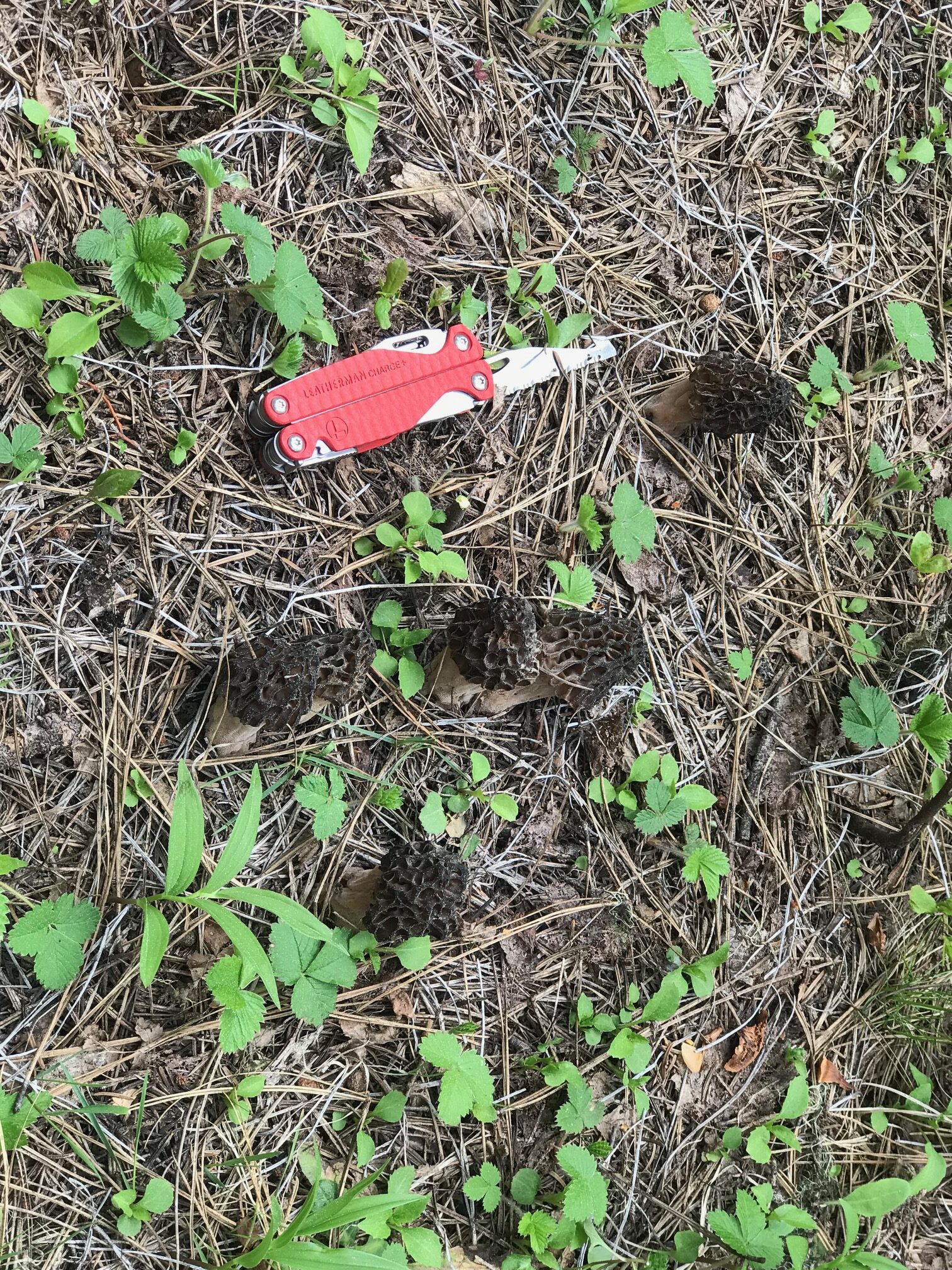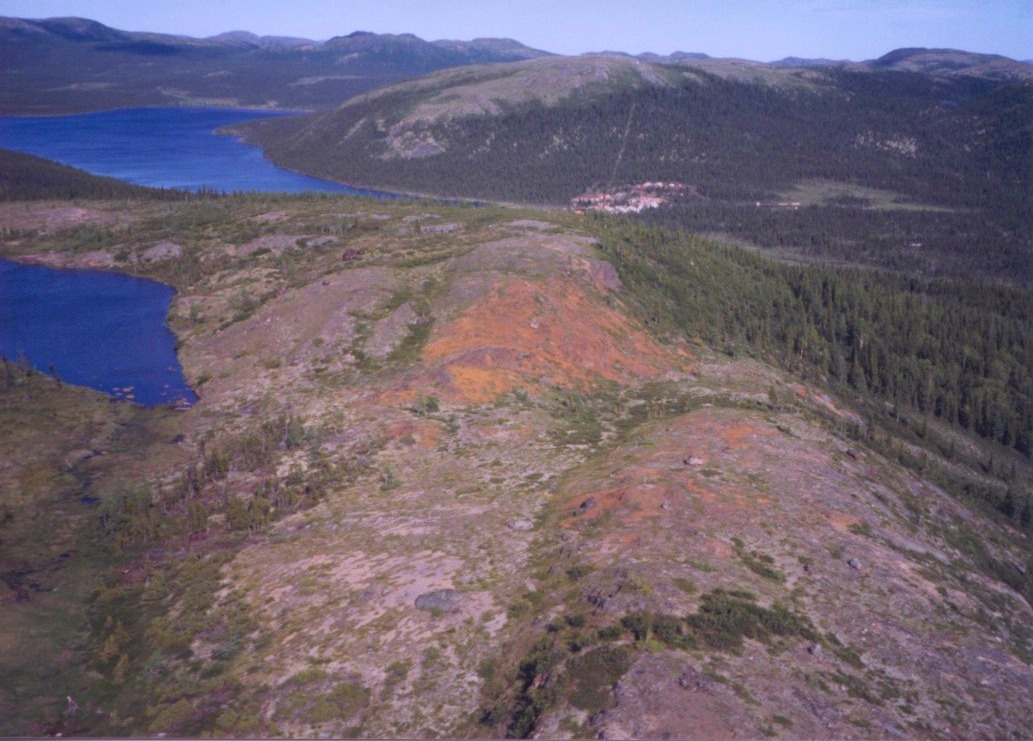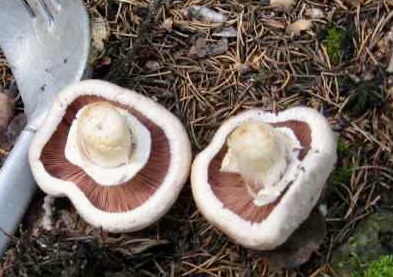
In May through June 2023 the forests near Joy’s place in Southern Oregon were sprouting both the early Blonde Morels (Morchella americana) and later Black Morels (Morchella elata.) I had never seen so many and many so large. Joy cooked them up to make a Creamy Morel Mushroom Pasta, which was a big hit with Joy’s nephew Dan and his wife Larah (who drove down from Portland to hunt for Morels.
Later in June and early July we found the Spring King Bolete (Boletus rex-varis) sprouting in sunnier clearings, where the morels were sprouting in the shadier areas. We sautéd these and their texture was more like a potato.


A Mushroom Saga (Part 3 of 3)

Nain, Labrador 1995 — “Gossan” is the Welsh word for “blood.” Prospectors always look for gossans, the blood-rust-colored earth which often occurs over sulfide ore-bodies. Early in January, our exploration team had discovered one of the richest nickel-copper ore-bodies of the 20th Century about one mile east of a hillside gossan. In late August, I was taking journalists around the gossan and telling them about our discovery.
While I was explaining how the geophysics was used to map the underground geology and mineralization, I spied some lighter-colored King Boletes (Boletus edulis) sprouting near a drill-site. “How ’bout gourmet mushrooms with our caribou steaks tonight?” I tell them.
Our camp cook is an Inuit woman (“Eskimo” is derogatory) who is none too happy when I bring her Boletes from the gossan.
“What do you want me to do with these?” she asks.
I say, “Do you have any olive oil?”
“Hell no,” is the reply, “this is the Arctic and olives don’t grow up here.”
“Okay, how ’bout butter?” I tell her, “just sauté the ‘shrooms in a little butter and put them on my caribou steak.”She brings out my ‘shrooms and steak, making a point to hold the dish as far away from her as she possibly can.
The dish was very good, and the ‘shrooms complemented the Canadian beer too. One of the drillers even tried a small bite, and said they were very good.
The next morning all the Inuit and geos in the camp seemed amazed I was still alive after eating the shrooms. So I tease them over my coffee, and pout how they could ever doubt their Chief Geophysicist?
Later that morning, while I was making maps, there was a knock on my field-office door. I opened the door, to find about twenty old Inuits (the town elders) standing outside. Their interpreter told me that the elders had heard of my mushroom identification skills, and hoped that I could teach them about the mushrooms sprouting around Nain. He explained that their grand-parents had been the last generation to know the good eating mushrooms.
In the 1920’s, Canadian and German Christian missionaries came to teach the Inuit the modern ways. The missionaries apparently had told them that mushrooms can be difficult to identify, and never to eat them. In ’96, some of the Inuit were beginning to question these beliefs, and wanted to learn about the local ‘shrooms.
Well, I was both honored and flabbergasted. I told my staff to handle the maps and called my chopper pilot to give me and a few senior Inuit a ride to the mushrooms. I showed them both the edible and inedible ones. They were very grateful, and on my next trip I brought them a good mushroom field-guide. The same mushrooms at Colorado’s +8000-foot elevation grow near sea-level in Labrador.
They had a little ceremony for me, and now Crebs is a kind of honorary Inuit.
A little sad though, too bad some guy from over 9,000 miles away had to teach a native aboriginal group about their traditional local delicacies.
A Mushrrom Saga (Part 2 of 3)
Union Elementary School, Utah 1957 — It’s my first month in the first grade. I enjoy nap time, but recess is grand as there is just so much to explore on the school baseball fields and nearby irrigation canals. During one of my first recesses, I spy some Meadow Mushrooms sprouting beneath the old wooden bleachers. Alas, I have neither trowel nor basket, so I dig them out with a stick and use my baseball cap as a makeshift basket. The other kids, watch me dig and soon a crowd of older kids is around telling me to throw those Toadstools” away, as they’ll kill you. “Oh baloney,” I say, “these are yummy. Come on, I’ll take them to show Mrs. Jacobsen, my new first-grade teacher. She’ll tell you to just look for the pink gills.” Soon some of my buddies are digging up mushrooms too. The older kids were dubious, but we first-graders were so proud!
Bad move. Mrs. Jacobsen was horrified at the capful of Meadow Mushrooms we had so proudly placed on her desk after recess. “These are POISONOUS TOADSTOOLS,” she declared and summarily tossed them in the trash can, and called for the janitor to take them away. I was humiliated, and began to cry.
Later, I remember tearfully telling my Mom, what had happened after recess. She just chuckled, and said: “… sometimes even our teachers are wrong. Nobody knows everything about everything. I am proud of you, but do not to pick mushrooms at school anymore—it will just upset everyone again.”
At six years old, this first-grader was learning to distrust authority figures.
A Mushroom Saga (Part 1 of 3)

Midvale Cemetery, Utah 1956 — My grandmother Eleni Kastani Pangos (aka Helen) and my Aunt Sylvia (Mom’s older sister) decide to go mushroom hunting after some fine September rain, and also decide to take me along to carry the basket and trowels. North American Greeks call the month of September, the Rain Month (φεγγάρια της βροχής), a time to go ‘shrooming. Wild mushrooms are thought have been an important component of Greek cuisine for at least 6000 years. Turns out the best place to pick the beautiful Meadow Mushroom (Agaricus campestris) is the local cemetery. I loved mushrooming, and quickly learned the best mushrooms have pink gills (young and tasty, brown gills denote old) and smell earthy and heavenly. The Meadows like to hide behind headstones, but I’m quick and always find them. Mummee (what we all called our grandmother—later, I learned it’s Greek for “midwife,” and she was somewhat famous at it) warned me to always check the gills, as the ones with white gills will make you sick. The Little Brown Mushrooms were never picked as they make you sick too.
At the tender age of five, I was a budding amateur mycologist.